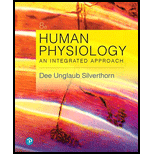
Concept explainers
List the three basic forms of work and give a physiological example of each.
To determine: The three basic forms of work with their examples.
Introduction: Biomolecules provide energy to animals and animals used this energy to perform their daily activities. The capacity to complete a task is known as energy.
Explanation of Solution
In a biological system, work can be in three forms, which are as follows:
- Chemical work:
The cleaving and forming the bonds in a chemical reaction is a form of work. This form of work is known as chemical work. Chemical work enables the growth of cells, maintenance of the environment inside the body, and information storage. For example, in protein chemical bonds are formed, which is an example of chemical work.
- Transport work:
In the body of humans, many concentration gradients are made by transport work. Transport work enables the movement of the ions and molecules across the membrane. For example, calcium ion is imported from the cytosol to cell organelles. In this work, endoplasmic reticulum utilizes energy, and the movement of ions helps in the contraction of muscles.
- Mechanical work:
Animals use mechanical work for their movement. For examples, the movement of organelles in the cell, change in the shape of the cell, and the movement of filaments and cilia.
Therefore, the three forms of work are mechanical work, chemical work, and transport work.
Want to see more full solutions like this?
Chapter 4 Solutions
Human Physiology: An Integrated Approach (8th Edition)
- What is the structure and function of Eukaryotic cells, including their organelles? How are Eukaryotic cells different than Prokaryotic cells, in terms of evolution which form of the cell might have came first? How do Eukaryotic cells become malignant (cancerous)?arrow_forwardWhat are the roles of DNA and proteins inside of the cell? What are the building blocks or molecular components of the DNA and proteins? How are proteins produced within the cell? What connection is there between DNA, proteins, and the cell cycle? What is the relationship between DNA, proteins, and Cancer?arrow_forwardWhy cells go through various types of cell division and how eukaryotic cells control cell growth through the cell cycle control system?arrow_forward
- In one paragraph show how atoms and they're structure are related to the structure of dna and proteins. Talk about what atoms are. what they're made of, why chemical bonding is important to DNA?arrow_forwardWhat are the structure and properties of atoms and chemical bonds (especially how they relate to DNA and proteins).arrow_forwardThe Sentinel Cell: Nature’s Answer to Cancer?arrow_forward
- Molecular Biology Question You are working to characterize a novel protein in mice. Analysis shows that high levels of the primary transcript that codes for this protein are found in tissue from the brain, muscle, liver, and pancreas. However, an antibody that recognizes the C-terminal portion of the protein indicates that the protein is present in brain, muscle, and liver, but not in the pancreas. What is the most likely explanation for this result?arrow_forwardMolecular Biology Explain/discuss how “slow stop” and “quick/fast stop” mutants wereused to identify different protein involved in DNA replication in E. coli.arrow_forwardMolecular Biology Question A gene that codes for a protein was removed from a eukaryotic cell and inserted into a prokaryotic cell. Although the gene was successfully transcribed and translated, it produced a different protein than it produced in the eukaryotic cell. What is the most likely explanation?arrow_forward
- Lifetime Physical Fitness & WellnessHealth & NutritionISBN:9781337677509Author:HOEGERPublisher:CengageCase Studies In Health Information ManagementBiologyISBN:9781337676908Author:SCHNERINGPublisher:Cengage





